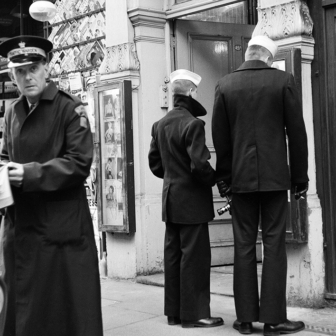Let me introduce Australia’s pre-eminent film critic between the two world wars, Kenneth Slessor. He is also one of our most significant film critics. He wrote about film at a length and with a depth that wouldn’t be rivalled in any news outlet until Inside Story’s Sylvia Lawson started contributing her reviews to Nation in the late 1950s. His vehicle was the populist weekly newspaper Smith’s Weekly, of which he was senior journalist, leader writer and eventually editor.
For nearly all of the 1930s Slessor edited Smith Weekly’s film pages under the title of “Through Smith’s Private Projector Conducted By Kenneth Slessor.” These film pages had a coverage of the cinema that was not matched in any national mass circulation Australian publication, then or since. Comprehensive reviews ran alongside news items, gossip, opinion and humorous pieces, light verse, and line drawings of film scenes, actors and industry personnel. Not only that: Slessor and Smith’s also waged campaigns through these pages – against the censor, for a better deal for country exhibitors and viewers, and for particular films and film-makers.
This is decidedly not the familiar Slessor, the man best known as Australia’s foremost poet between the two world wars. Poems like “Five Bells,” “Five Visions of Captain Cook” and “Beach Burial” could claim an importance in the Australian literature of any period. Long featured on the reading list for high schools, this verse provided for many of us our first encounter with Slessor. When he is not known for his poetry he is known for his contribution to Australian literary criticism and journalism. A visit to a good library will yield anthologised selections of his reportage, book reviews and war despatches, as well as his wartime diaries as official AIF correspondent during most of the second world war.
Yet his film criticism has simply dropped out of sight. His biographer, Geoffrey Dutton, skates over his role as chief film critic and “conductor” of Smith’s Weekly’s extensive cinema pages during the 1930s, instead focusing on the things that strike Dutton as important to Slessor’s formation as a poet and senior journalist. Slessor himself contributed to this omission. He didn’t consider any of his film reviews worthy of inclusion in his 1970 collection of prose writing, Bread and Wine, and by the 1950s he had moved away from writing about film. He stressed instead his contribution to serious poetry and journalism.
Slessor’s film criticism has fared no better with film historians. We didn’t anthologise or cite him in our readers, books or essays. His lengthy essays about the film-maker Charles Chauvel, his advocacy of the McDonagh sisters’ Two Minutes Silence and his ongoing disputes with the censor were mostly invisible to us. So thoroughly was Slessor made over into “poet and wartime journalist” we didn’t even think to look.
Estimations started to change when Philip Mead noted a feature of his poetry that, once observed, becomes blindingly obvious. His poetry is a form of cinematism – a performance of the cinema by other means. In his book Networked Language: Culture & History in Australian Poetry, Mead argued that Slessor’s major poems were best understood as his response to the cinema. He pointed to Slessor’s extraordinarily intense involvement with the cinema from the 1920s, and especially in the 1930s, when his film reviewing had become central to his journalistic activity.
Seen in this light, Slessor’s film reviewing and other film writing is not only important to understanding his poetry and poetics but is likewise a response to and writing with the cinema. Mead concluded that not only those interested in literature but also those interested in film needed to take Slessor seriously, not least so we could make sense of our film history and the presence of cinema-going in the cultural and social life of Australia in the 1930s.
Soon after reading Networked Language Huw Walmsley-Evans and I approached Philip Mead to collaborate on filling out Slessor’s contribution as a film critic. We approached the online cinema journal Screening the Past and they agreed that we should assemble a “dossier” on Slessor consisting of a jointly written overview essay situating and assessing Slessor’s film involvements and coupled with a modest selection of his film reviews. To give Inside Story readers a sense of Slessor’s film reviewing we have reproduced two of his reviews – appraisals of John Ford’s The Informer and the 1935 MGM action film China Seas – below.
Restoring the cinema to Slessor not only recasts estimations of his poetry. It also gets us to recognise that the notion of an Australian national cinema – which we film historians had seen as a late 1950s and 1960s phenomenon coming out of the conjunction of film societies, film festivals and dedicated film publications, mediated through journals and newspapers – was first articulated in Slessor’s advocacy for and response to the Australian cinema of the 1930s. It also gets us, at a time when we are experiencing our own digital transformations reshaping film, television and publishing, to appreciate how his film criticism and film writing were a creative response to the drastic media transformations that were taking place around him with the coming of sound. For Slessor writing in 1931, the significance of the coming of sound for the film world could “only be compared to a sort of French Revolution – the upsetting of accepted standards, and the enthronement of strange gods.” As he wrote in Smith’s Weekly in January 1931, he was in the midst of an “Elizabethan age of entertainment” in which “vague, golden isles in the mists are floating on the edges of our maps.”
Slessor saw himself as tracing and responding to the new kind of cinema, the sound cinema, that was coming into being before his eyes. His film criticism was of a new kind being improvised around the world as a response to the circumstance and possibilities of the sound cinema. It was one that accommodated an attention not just to performance and performers but also to film language, film genres and film directors. While this is the form film reviewing now takes, Slessor’s reviews carry the additional excitement of invention – of finding the right words and the appropriate response to the sound cinema as he conjured it in words for his readership.
You would probably expect a film person to say this. But we think Slessor’s major contribution to Australian letters and literary journalism lies, like Graham Greene’s, with his film reviews. They deserve a wider readership. This is a first step. •
Kenneth Slessor reviews “The Informer”
Smith’s Weekly, 24 August 1935
Whether or not the crude alcohol of The Informer is in danger of dismaying those cordial-loving and ticket-buying masses on whom, I am assured by experts, the picture industry is built, there can be no question about its native strength, its disturbing realism, and its authentic play of tragedy and humour. I can go further than this, and say that personally I think The Informer is the finest picture that I have so far seen in this year of abnormally good pictures.
With the exception of one passage at the end (and it is hard to understand how this can have been joined to the consummate perfection of the rest), there is literally nothing on which even the most citric critic could base depreciation. The story is by Liam O’Flaherty, who (as you will guess) is not an Armenian, and who offers no compromise to reality. It is a hard, harsh story, simple in outline, as with the outline of most tragedies. It moves on a predestined, inevitable course; from the motive of a moral crime through a reactive interval of mad jubilation to the only ending. The “Informer” is not a vicious or a criminal type; the tragedy is that he is a human being, moved by instincts and circumstances to a fate that is inexorable, if unforeseen. In this awful study of a tormented man, driven by starvation to betray his friend, it is difficult to say whether most credit should be paid to the book by O’Flaherty, the direction by John Ford, or the astonishing acting of Victor McLaglen.
Thanks to these three, the picture is something more than entertainment. It has the odour of raw life. You cough in the fog, feel physical pain, smell the reek of whisky and fish. The film, in fact, has the feeling of true poverty – intense, miserable, aching poverty – not the sentimental poverty of tradition. The dreadful days of Dublin in 1922 are explained, perhaps for the first time, as no newspaper could explain them.
The genius of the director begins to work without flourish or ornament in the very first reel. There is hardly a word of dialogue for the first ten minutes. But gesture and symbol build up the emotional scene on which the picture is founded. The smoking mist, the wind and fog, the flaring street-lights, all these serve to speak for the players. And here there is an exquisite touch of metaphor; for the police-bill of the “wanted” man, flying in the gale at the feet of the “Informer,” symbolises the shameful thought which keeps flying at his mind. The director is rich with these effects; as, for example, the exaggerated ticking of the police clock, whilst soldiers are on their way to kill their quarry. The shooting of Frankie McPhillip is almost shockingly realistic.
Victor McLaglen staggers all previous ideas of his ability by the strength of his performance as the “Informer.” The “Informer” is shown as a simple, childish, stupid giant, without even the cunning of the traitor, but somehow terrible or pathetic in his human stupidity. He is soaked in whisky, the drug that fogs his own remorse; he scatters fried fish and his blood-money with a child’s generosity; there are some terrific scenes of drunkenness. The interlude in the shebeen might have been painted by an Irish Hogarth. Here, too, the splendid acting of the minor players is at its best, particularly the performance of the loathsome hanger-on (played by Neil Fitzgerald), who crowns the drunken Croesus as “King” with true Irish hyperbole. From these scenes to the dramatic trial of Gypo is a coldly and terribly related process. It is hard to forget the struggles of this rat-brain, caught in a merciless trap.
And here, with the agonised confession, “I don’t know why I did it, I don’t know why,” the picture should have ended. That it trails on to a theatrical anti-climax, with the “Informer” dying before an altar, does not impair the power of the whole – though the ticket-buying masses whistled to keep their spirits up at the first night in Sydney. An astonishingly good picture this (so good that it is not damaged by the curtain), and one that belongs to the curious history of the screen of 1935. – K.S.
Kenneth Slessor reviews “China Seas”
Smith’s Weekly, 1 April 1936
After a steady examination of this picture, I have decided against taking a rest-cure in Chinese waters. Woy Woy will do me. What with the typhoons, hurricanes, pirates, torture, and sudden death which seem to be chucked in with a pleasure-cruise in China Seas, it must all be very galling and exasperating. The remarkable thing about the travellers in this film is that, having survived the typhoons and pirates, they don’t seem to care two hoots – no more than travellers on the Bellevue Hill tram-line care about such minor annoyances as a hold-up at the power-house.
As you can see, the film is highly-coloured; it is, in fact, full of vigorous rough-and-tumble, pungent humour, and sentimental moonlight. And the players enjoy themselves with a gusto which will transmit itself to you. The star-system has its drawbacks as well as its advantages. One of the principal defects is that a popular player appears in each new role trailing clouds of ancient glory behind him, so that it is hard to dissociate him from the last two parts, or last half-dozen parts, in which he has acted. It comes as a bit of a shock, certainly, to find, when all the passengers have marched up in the gangway here, that the boat holds in close proximity none less than our old friends, Jean Harlow, Clark Gable, Wallace Beery, Lewis Stone, and C. Aubrey Smith. You feel like saying, as each remembered face comes down the deck, “Fancy meeting you.”
The film, as you will have gathered, belongs to the vehicular series. Sometimes this sort of story takes place on an express-train, sometimes in a passenger-aeroplane or a luxury-liner. There have been scores of pictures made on the same design, and of these, Shanghai Express bears a rough resemblance to China Seas, with the difference that a steam-boat is substituted for a railway-train. But, in this vehicular series, China Seas goes up very near the top. It moves so quickly, the excitement is so cleverly transferred from scene to scene, and the characters themselves have been so broadly, yet so deeply, painted, that for an hour or so you find yourself sailing with the pirates from Hong Kong.
The director (Tay Garnett) has packed the colour of Crosbie Garstin’s book into the picture with astonishing realism. As the boat slides away from Hong Kong you can almost smell the East; and smelling the East, as experienced travellers have remarked, is one of life’s major experiences. As usual, a wildly assorted section of humanity is flung together on board. There is Clark Gable, the skipper, who actually makes his first appearance with a three-days’ growth of whisker; there is Jean Harlow, the “China Doll,” a lady of that mythical type which enlivens the works of Robert C. Service; and Wallace Berry, as an adventurer, and C. Aubrey Smith, the perfect ship-owner, and Robert Benchley, as a mythical drunken novelist (no practising novelist can afford to be drunk); and Rosalind Russell as a snooty English beauty. All of them fit their frames, though the transformation of Beery from a genial boozer to a bloodthirsty villain, and back to a Heart of Gold again, is rather inconceivable. Clark Gable acts with his usual brisk neatness. He’s English here, but the transatlantic idiom creeps shyly through. Jean Harlow is excellent in spots, where her scratchy, rending, zinc-like voice suits the situations. But she has her limitations as a dramatic actress, and in some of the loudly-yelled emotional passages her voice becomes a little trying. Robert Benchley, better-known as a humourist, lurks humorously at the edge. He is drunk continuously (you can’t blame him, what with the typhoons and one thing and another), and makes a series of abrupt vertical exits down holds and shafts.
But these criticisms don’t destroy the fact that everybody in the picture plays with the richest unction. Take a team of first-class players, with a galloping good adventure-story, and let them enjoy themselves like this, and the result won’t be in doubt. You’ll enjoy China Seas. – K.S.




